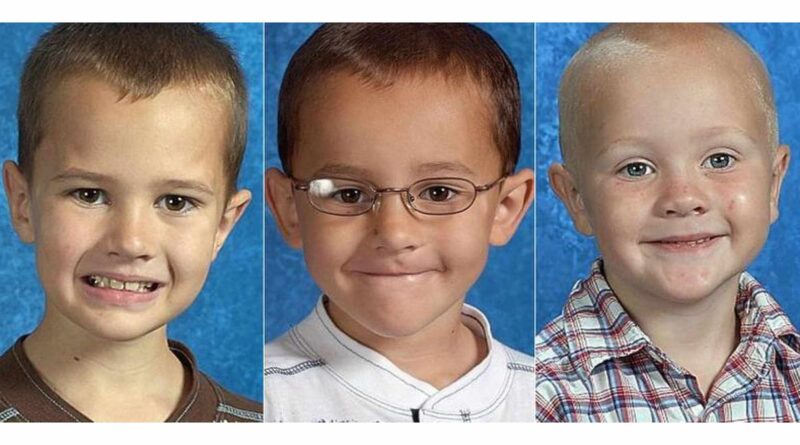Skeleton Brothers Disappearance in Morenci Michigan
On Thanksgiving weekend in 2010, a routine family arrangement spiraled into one of Michigan’s most enduring and emotionally wrenching missing children mysteries. Andrew (9), Alexander (7), and Tanner Skelton (5) were last seen in Morenci, Michigan, on November 26, 2010, in the care of their father, John Skelton. What followed was silence: no trace of the boys, conflicting explanations from the only adult known to have them, and a cascade of legal and emotional fallout that would span more than a decade. Their disappearance remains officially unresolved, though the judicial system has taken steps toward closure, and the specter of what happened has left deep scars on their family, community, and those who have followed the case.
Who They Were and the Circumstances Leading Up
Andrew, Alexander, and Tanner Skelton were brothers caught in the middle of a contentious custody dispute between their parents. Their mother, Tanya Zuvers (née Skelton), had custody of the boys, while their father, John Skelton, maintained visitation rights. The relationship between the parents was fractured, marked by conflict and prior attempts at unauthorized taking of the children. Against that backdrop, John Skelton was granted visitation over the Thanksgiving holiday in 2010. The boys went with him as expected—but they never returned.
The last confirmed contact with the boys was through their father, who was supposed to bring them back to their mother as scheduled. Instead, the days that followed saw increasingly inconsistent and evasive explanations from John Skelton. He claimed a variety of things over time, including that the boys had been given to unknown individuals, that they were safe somewhere unspecified, or bizarre, non-credible stories suggesting they were “hibernating.” None of these explanations held up under scrutiny. Investigators, family members, and the larger community faced the growing horror that the boys had vanished and that the person with the most knowledge was refusing to or unable to account for their whereabouts.
The Initial Shock and Investigation
When the boys failed to return and contact with them faded, an Amber Alert was issued, and law enforcement launched an investigation. The case immediately zeroed in on their father as the last known adult custodian. Investigators tracked his movements using available technical data such as phone records, which placed him in Michigan and briefly in Ohio in the immediate aftermath of the disappearance. Despite intense scrutiny, no physical evidence of the boys’ whereabouts ever surfaced. No bodies. No confirmed sightings. No reliable lead.
John Skelton’s early statements were inconsistent. He offered false leads, made claims of having given the boys to unnamed associates, and even floated fantastical explanations that seemed intended to deflect attention rather than illuminate truth. The pattern of behavior—unexplained disappearance coupled with equivocal and misleading narratives—heightened suspicion among investigators and observers. The situation was compounded by bitterness and distrust between the parents, which complicated public perception and the emotional contours of the investigation.
Law enforcement viewed the case through the lens of a possible custodial abduction that turned into something far more sinister. The absence of the children and the lack of cooperation from their father generated enormous frustration. Prosecutors and detectives were limited: they had a man with custody who was evasive, a disappearance with no positive leads, and a family embroiled in conflict over narrative and blame. As months stretched into years, hope dimmed for many, even as a dedicated core of law enforcement and family pushed to keep the case alive.
Legal Fallout and John Skelton’s Conviction
In 2011, John Skelton faced legal consequences not for the disappearance in a full sense—no charges were ever brought for homicide or definitive knowledge of the boys’ fates—but instead was prosecuted for unlawful imprisonment/parental kidnapping and related procedural violations. He pleaded guilty to those related charges and received a sentence that included a prison term of 10 to 15 years. The plea deal reflected the limitations of what prosecutors could prove beyond a reasonable doubt about the boys’ disappearance versus the concrete evidence available about his failure to return them and the unlawful withholding.
Despite serving time, Skelton never provided credible, verifiable information about Andrew, Alexander, and Tanner. His release timeline became a focal point of anxiety for the missing boys’ supporters, because even after incarceration, the core mystery remained unchanged: where were the boys, and what had happened to them over the Thanksgiving of 2010 and thereafter? His refusal or inability to cooperate with meaningful detail left the case in a suspended state, with justice partial and closure distant.
The Long Shadow: Years of Uncertainty and Speculation
Over the next decade and more, the Skelton brothers’ case entered the space occupied by unresolved tragedies—known to many, speculated about by some, and emotionally raw for those closest. The absence of physical evidence opened the door to a spectrum of theories ranging from the most hopeful to the darkest. Some held onto the possibility that the boys had been hidden away somewhere, perhaps under force or manipulation, and were being kept from contact deliberately. Others, looking at the contradictions in their father’s stories and his silence, feared the worst—that the boys had been harmed or killed, and that their location would remain a secret guarded by the one person with the most proximate control over them.
Theories circulated online and within communities: suggestions that the boys were trafficked, that some kind of clandestine network had quietly taken and concealed them, or that their father had involvement in their deaths and had hidden the truth. Alternative theories speculating about new identities or being forced into silence by trauma were also discussed. The lack of firm answers created emotional whiplash for family members who had to live publicly with grief, privately with hope, and constantly with suspicion.
The case drew attention in true crime communities, local news, and from armchair investigators fascinated and appalled by the gaps between known facts and remaining unknowns. Advocates underscored the structural consequences of unresolved parental abductions and examined whether any systemic failures in oversight, legal follow-through, or inter-agency cooperation might have contributed to the inability to recover the boys or to compel disclosure from their father.
Search Efforts, Public Appeals, and Media Interest
As the years passed, the search for the Skelton brothers evolved in form. What began as active, tip-driven canvassing with law enforcement expanded into public advocacy, renewed media coverage around anniversaries, and legal maneuvers intended to create frameworks of recognition. The boys’ mother and supporters conducted public appeals, attended hearings, pressed authorities for renewed investigation, and tried to keep the boys’ names in the public consciousness to prevent the case from fading into the background of forgotten tragedies.
Media coverage often emphasized the unresolved tension between a legal system that had punished the father on related procedural charges and a moral imperative for deeper answers about the boys’ fates. Public interest mixed true concern with speculation, but it also brought forward the idea that time alone should not erase the obligation to try and find the missing children or to force transparency from those with the most direct connection.
The Move Toward Formal Closure: Legal Declaration of Death
After more than 14 years of living in limbo, the boys’ mother sought a legal mechanism to gain a form of closure. In early 2025, Tanya Zuvers pursued a declaratory judgment to have her three sons formally declared dead. The action was as much symbolic as practical—a recognition by the court that the absence was no longer a temporary unknown but a long-term, defining loss.
On March 5, 2025, a judge in Lenawee County granted her petition. The court declared Andrew, Alexander, and Tanner Skelton legally dead, setting their presumed date of death as November 26, 2010—the day they vanished. The ruling allowed the family to acknowledge their loss in a legal context, to take certain administrative steps previously blocked by the lack of a declaration, and to honor their memory with a degree of formal recognition that had long been denied.
Importantly, the court did not formally assign legal responsibility for their deaths to their father, despite investigators’ long-standing suspicions and his status as the last known adult to have had them. The judge concluded that the evidence did not meet the threshold of “clear and convincing” required to declare him responsible for their deaths in that proceeding. That nuance crystallized the painful complexity of the case: grief and presumed loss officially recognized, yet the deeper truth—what happened to the boys and who beyond a shadow of suspicion ordered or executed it—remained unanswered.
The Psychological, Social, and Cultural Impact
The disappearance of the Skelton brothers and the subsequent decades of ambiguity had layered effects. For their mother, it was an enduring trauma that mixed public scrutiny with private heartbreak. For the father, it became a figure of public suspicion and legal consequence, even as he never provided the full story. For the community of Morenci and surrounding regions, it served as a cautionary example of fragility in family custody dynamics, the limits of legal recourse, and the long-term damage inflicted when children vanish without a narrative resolution.
Online communities, especially those invested in unresolved mysteries, debated the ethics of continued speculation versus respect for a family’s ongoing grief. The case also prompted introspection among law enforcement circles about how cold parental abduction cases are managed over time, how leads are preserved, and how to reconcile the tension between punishing procedural violations if the larger substantive mystery (the children’s condition or location) is unsolved.
The declaration of death in 2025, while providing a legal endpoint of sorts, did not heal the emotional ruptures. Instead, it layered on a different kind of grief—the official acknowledgment that the boys were gone, even as their physical fates remained obscured. That paradox is central to understanding the case’s impact: closure without certainty, loss without explanation.
Unresolved Questions and Theories That Persist
Despite the legal recognition of their presumed deaths, the core questions endure. What exactly happened to Andrew, Alexander, and Tanner after they were last in their father’s care? Did John Skelton act alone, or were others involved, either in abduction, concealment, or in perpetuating silence? Did the boys suffer harm immediately, or were they moved, hidden, or manipulated over time? Theories about secretive networks, coercion, or deliberate concealment by a parent who sought to erase the past persist in conversations not because they are grounded in new evidence, but because the absence of disclosure leaves cognitive space that humans naturally fill with plausible nightmares.
Some have speculated that if the boys had been alive beyond their disappearance, they might have been psychologically conditioned to not speak, or placed into environments where they were kept out of contact. Others maintain the more tragic hypothesis—that they were killed early and the truth has been guarded ever since, with their father either complicit in the concealment or acting alone. The lack of discovery of remains feeds both pain and speculation, making definitive narrative closure elusive.
Lessons and Legacy
The Skelton brothers’ case exemplifies how modern disappearances, particularly those involving parental figures, can defy binary understanding. It illustrates painful gaps in the intersection of familial conflict, law enforcement capacity, and the limits of judicial resolution when core facts cannot be fully established. It also highlights the vital importance of persistence by victims’ families, of keeping cases alive in public memory, and of the slow but occasionally decisive power of legal mechanisms to provide partial closure even when the full truth remains out of reach.
For missing children advocacy, the story emphasizes the significance of early response, of scrutinizing custodial abductions not just as temporary legal disputes but as potential long-term crises, and of offering surviving family members pathways to both emotional and administrative recognition of their loss when no physical return is possible.
Remembering Andrew, Alexander, and Tanner
At the center of legal filings, speculation, court dates, and investigative threads are three brothers: Andrew, Alexander, and Tanner. They were children with routines, holidays, and the trust to be returned from a visitation arrangement. Their absence reverberated in the empty spaces that children leave behind—unfinished meals, unclaimed presents, birthdays marked with placeholders, and a mother’s life shaped around the missing. Remembering them means holding the tension between what is known and what is unknown, honoring the love that persisted through uncertainty, and committing to keeping their story active in collective memory so that their disappearance does not fade into anonymity.
Conclusion
The disappearance of the Skelton brothers on November 26, 2010, constitutes a haunting puzzle of parenting conflict, possible abduction, legal constraint, and enduring grief. Their presumed deaths—officially declared more than 14 years later—brought a formal acknowledgement of loss, but not of how or why that loss occurred. The case sits in the uneasy space between legal closure and unresolved mystery: a family marked by absence, a father wrapped in suspicion yet not legally tied to the deepest allegation, and a community left to live with the reminder that some questions, even when time has passed, can remain stubbornly unanswered. Their story is a call to vigilance, compassion, and tenacity in searching for missing children—and a reminder that the human cost of ambiguity carries weight even decades later.
Discover more from City Towner
Subscribe to get the latest posts sent to your email.




